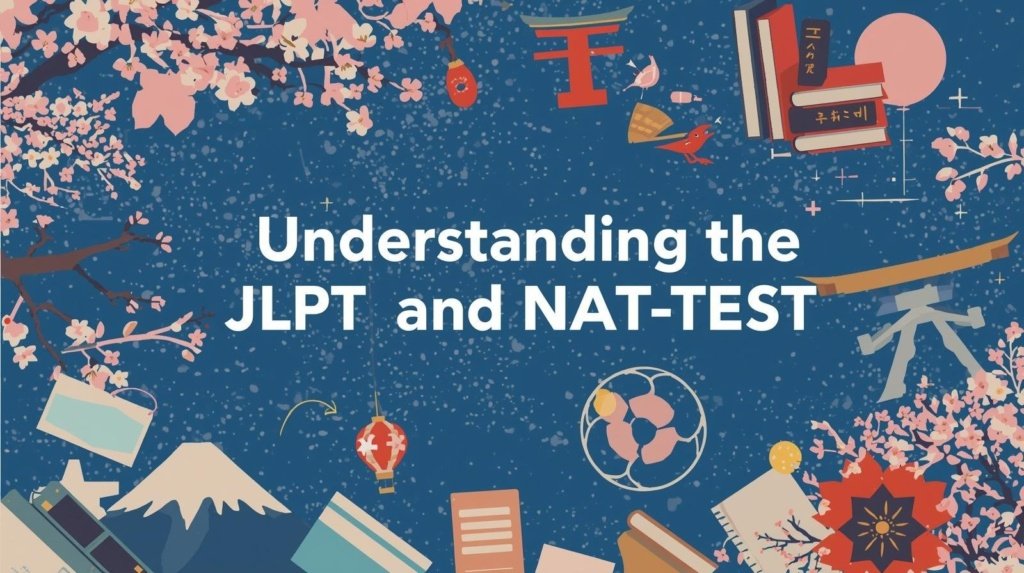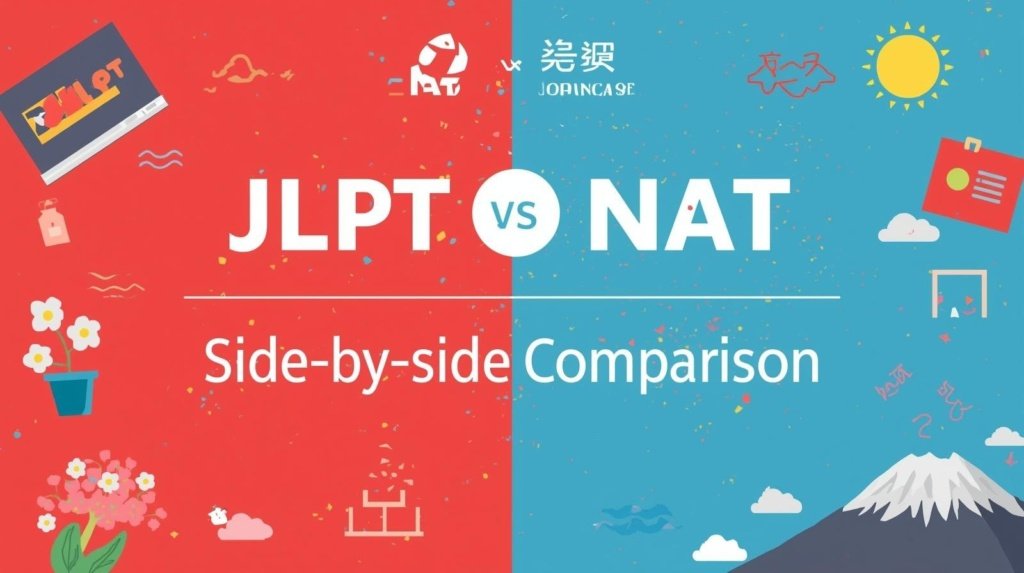JLPT vs NAT Learning Japanese is no longer just a hobby — it’s a gateway to exciting career opportunities, higher education in Japan, and cultural immersion. But if you’re aiming to certify your Japanese proficiency, one question always arises:
Should I take the JLPT (Japanese Language Proficiency Test) or the NAT-TEST (日本語NAT-TEST)? Both exams measure your Japanese language skills, but they differ in structure, recognition, difficulty, and purpose.
This guide breaks down the key differences and helps you decide which exam suits your goals best in 2025. Top Study Materials for JLPT Preparation
For expert guidance, join TLS – The Japanese Language School, where professionals train students for both JLPT and NAT exams.
Visit: 2/81-82, 2nd Floor, Lalita Park, Gali No – 2, Laxmi Nagar, New Delhi – 110092
Call: +91 8700956038 | Email: tls@teamlanguages.com
Understanding the JLPT and NAT-TEST
The JLPT (Japanese Language Proficiency Test) is a globally recognized exam, measuring reading, listening, grammar, and vocabulary across five levels, from N5 (beginner) to N1 (advanced). It’s ideal for students seeking official recognition for work, study, or visas in Japan. JLPT High Score Tips

The NAT-TEST (日本語NAT-TEST) focuses on practical, real-world Japanese and is held six times a year. Its levels correspond closely to JLPT, making it excellent for regular practice, confidence-building, and stepping-stone preparation toward JLPT certification. JLPT Registration Process 2025
JLPT (Japanese Language Proficiency Test)
The JLPT is the most globally recognized Japanese exam, accepted by universities, employers, and government bodies worldwide. Conducted by the Japan Foundation, it tests reading, listening, grammar, and vocabulary skills across five levels — N5 (beginner) to N1 (advanced).Official Website
Why JLPT Stands Out
The JLPT is held twice a year and is globally recognized for jobs, study, and visa applications. It offers a formal, comprehensive assessment of grammar, reading, listening, and vocabulary across five levels (N5–N1). Standardized scoring ensures reliable certification, making it ideal for students aiming for academic or professional opportunities in Japan. Visit JLPT Guide
- Held twice a year — in July and December, with worldwide availability.
- Globally recognized — accepted for jobs, education, and visa applications.
- Comprehensive assessment — focuses on grammar, reading, and listening comprehension.
- Reliable certification — standardized scoring ensures your results are respected internationally.
Take JLPT if you’re targeting professional or academic opportunities in Japan.
For a step-by-step prep plan, read: How to Crack JLPT Exam in First Attempt – Ultimate Guide How to Crack JLPT Exam in First Attempt – Ultimate Guide
NAT-TEST (日本語NAT-TEST)
The NAT-TEST is a newer, fast-growing Japanese proficiency exam, popular among students in India and Asia. Like JLPT, it evaluates grammar, reading, and listening — but it’s more practical and flexible. Official Website
Why NAT-TEST Is Gaining Popularity
The NAT-TEST emphasizes practical, real-world Japanese and is held six times a year, offering flexibility for frequent practice. Its levels align with JLPT, making it ideal for building confidence, improving skills, and serving as a stepping stone toward official JLPT certification. JLPT Exam Dates 2025
- Practical approach: Emphasizes everyday Japanese communication.
- Frequent exams: Conducted six times a year, perfect for regular practice.
- Level alignment: NAT Levels (1–5) correspond directly to JLPT (N1–N5).
- Growing recognition: Increasingly accepted in Asia and India for study and work.
: NAT Japanese Exam Date 2025 – Complete Schedule
The NAT Japanese Exam 2025 is held six times a year, offering flexible dates for students to practice regularly and track progress toward JLPT preparation. NAT Japanese Exam Date 2025 – Complete Schedule
JLPT vs NAT: A Side-by-Side Comparison
JLPT vs NAT differ in frequency, difficulty, and recognition. JLPT is held twice a year, globally recognized, and focuses on formal grammar, reading, and listening across levels N5 to N1. NAT-TEST is conducted six times a year, emphasizes practical Japanese, and aligns its levels with JLPT (Level 5 = N5, Level 1 = N1). JLPT suits students seeking official certification for work or study in Japan, while NAT is ideal for frequent practice, confidence-building, and preparation for JLPT. Apply for the NAT October 2025 exam online here.

| Feature | JLPT | NAT-TEST |
| Frequency | Twice a year (July & December) | Six times a year |
| Levels | N5 to N1 | Level 5 to Level 1 |
| Recognition | Global (for jobs, visas, and universities) | Growing in Asia & India |
| Difficulty | More formal and challenging | Moderate, focuses on practical skills |
| Best For | Study, work, or visa in Japan | Frequent practice and skill-building |
Takeaway:
- Choose JLPT if you need global recognition or plan to work/study in Japan.
- Choose NAT if you want frequent testing and confidence-building practice.
Which Test Is Better for You?
Choosing between JLPT vs NAT depends on your goals. JLPT suits study, work, or visa purposes, while NAT-TEST offers frequent practice, confidence-building, and flexible preparation for progressing toward JLPT certification. Basic Japanese Language Course Near Me – Your Guide
| Goal | Recommended Exam |
| Work or Study in Japan | JLPT |
| Frequent practice and progress tracking | NAT-TEST |
| Confidence-building before JLPT | NAT-TEST |
| Global career recognition | JLPT |
Pro Tip: Start with NAT-TEST for practice, then advance to JLPT for certification. JLPT Listening Skills
Learn Japanese with TLS – The Japanese Language School
At TLS – The Japanese Language School, we help students achieve success in both JLPT and NAT-TEST through a structured, personalized approach. Our experienced instructors provide comprehensive lessons covering grammar, kanji, reading, listening, and conversational skills. Regular mock tests track progress, while flexible online and offline classes accommodate different schedules. TLS also offers career guidance for studying or working in Japan, ensuring students gain not only exam readiness but also practical language skills for real-world Japanese communication and professional opportunities. Online Japanese Classes for Beginners – Your Guide

Why Students Choose TLS
Students choose TLS for expert instructors, structured courses covering grammar, kanji, reading, listening, and speaking, regular JLPT and NAT mock tests, flexible online/offline classes, and personalized career guidance for studying or working in Japan. JLPT N2 Preparation
- Expert Trainers: Native and certified Japanese instructors.
- Structured Curriculum: Covers grammar, kanji, listening, and speaking.
- Mock Tests: Regular JLPT & NAT simulations to track progress.
- Career Support: Guidance for study visas, job interviews, and Japan placements.
- Flexible Options: Online and offline classes available.
Join TLS today and turn your Japanese learning journey into a career-transforming experience.
Visit: 2/81-82, 2nd Floor, Lalita Park, Gali No – 2, Laxmi Nagar, New Delhi – 110092
Call: +91 8700956038 | Email: tls@teamlanguages.com
Exam Preparation Tips
Effective preparation for JLPT vs NAT requires focused study and regular practice. For JLPT, understand your target level, master kanji and grammar, solve official sample papers, and strengthen listening skills through Japanese media. For NAT-TEST, take advantage of its six yearly exams, practice practical conversation, review JLPT-aligned materials, and use flashcards for vocabulary retention. Structured courses and mock tests at TLS ensure comprehensive exam readiness. Mastering JLPT N5
JLPT Study Tips
Focus on your target level, master kanji and grammar, practice official sample papers, and improve listening through Japanese media. Japanese Language Course for JLPT – Your Path to Success
- Identify your target level (N5–N1) and focus on its grammar and kanji list.
- Solve official JLPT sample papers and previous years’ tests.
- Watch Japanese content (news, anime, podcasts) to boost listening skills.
- Study with structured guidance from TLS’s JLPT course.
NAT-TEST Study Tips
Take advantage of NAT-TEST’s six yearly exams for regular practice, focus on practical conversation and reading, review JLPT-aligned materials, and use flashcards or apps to retain essential vocabulary efficiently. Online Japanese Language Course with Certificate
- Practice frequently using NAT’s six yearly exam opportunities.
- Focus on practical conversation and reading.
- Review JLPT resources for cross-preparation.
- Build vocabulary with flashcards and repetition tools.
FAQs: JLPT vs NAT
1. Is NAT accepted in Japan?
The NAT-TEST has been gaining popularity among certain Japanese universities and employers, especially for practical skill assessment. However, the JLPT remains the official standard for professional recognition, visa applications, and higher education in Japan. Students who want international credibility and strong career prospects should focus on JLPT certification, while NAT is ideal for building confidence and testing practical language abilities.
2. Which exam is easier?
When comparing difficulty, the NAT-TEST is generally considered easier because it emphasizes real-world Japanese skills, such as listening and reading comprehension in everyday contexts. On the other hand, the JLPT tests formal grammar, complex vocabulary, and structured comprehension. Higher JLPT levels like N2 and N1 are particularly challenging and require dedicated study, making NAT a good preliminary step before attempting JLPT.
3. Can NAT replace JLPT for visas?
No. For most Japanese visa applications, work opportunities, or professional certifications, JLPT certification at N2 or N1 level is mandatory. While NAT-TEST is excellent for skill-building and practice, it cannot replace JLPT for official purposes. Using NAT as a supplementary tool can help you prepare more effectively for JLPT.
4. How often are these exams held?
The JLPT is conducted twice a year, in July and December, which allows students to plan long-term preparation strategies. The NAT-TEST, however, is held six times a year, offering greater flexibility for learners who want frequent testing, continuous improvement, and better tracking of their progress. This makes NAT ideal for beginners or those looking to gradually build their skills.
5. Which exam is better for Indian students in 2025?
For students in India, JLPT is the preferred choice for those who aim for global recognition, professional opportunities in Japan, or academic advancement. NAT-TEST, however, serves as an excellent practice tool for regular learning, skill improvement, and confidence-building before attempting JLPT. Many students choose to start with NAT to assess their level and strengthen practical skills before committing to JLPT.
6. Can I take both exams in one year?
Yes, and this is a common approach. Students often take the NAT-TEST first to evaluate their practical Japanese skills and build confidence. Once comfortable, they attempt JLPT for official certification, which is recognized by universities, employers, and visa authorities. This combination helps learners achieve both practical fluency and formal recognition.
7. Are online courses effective for preparation?
Absolutely. Structured online Japanese courses, like those offered by TLS, provide live interactive classes, mock tests, and expert guidance. These courses allow learners to prepare efficiently from anywhere, balancing work, studies, or other commitments. Online courses can help with both JLPT and NAT-TEST, covering grammar, vocabulary, reading, writing, and listening skills systematically.
8. What are the level equivalencies between JLPT and NAT?
Understanding how NAT aligns with JLPT helps learners plan their preparation strategically. The equivalencies are:
- NAT Level 5 = JLPT N5
- NAT Level 4 = JLPT N4
- NAT Level 3 = JLPT N3
- NAT Level 2 = JLPT N2
- NAT Level 1 = JLPT N1
This alignment makes NAT a practical stepping stone toward JLPT certification, helping learners progress step by step.
9. Does NAT help in JLPT preparation?
Yes. NAT-TEST is particularly useful for practicing reading comprehension, listening, and grammar, which are core components of JLPT. By attempting NAT, students become familiar with exam formats, time management, and question patterns, making JLPT preparation more effective and less stressful.
10. Which exam is better for career opportunities in Japan?
While NAT-TEST improves practical language skills and confidence, JLPT is more widely recognized for employment, visas, and higher education. Japanese employers, universities, and immigration authorities typically require JLPT certification, especially N2 or N1 levels. NAT complements JLPT by enhancing communication skills, but JLPT remains essential for official career advancement in Japan..
Conclusion
Both JLPT and NAT-TEST are valuable for showcasing your Japanese proficiency — your choice depends on your goals and timeline.
- Choose JLPT for official recognition, higher studies, or working in Japan.
- Choose NAT for frequent testing, practical learning, and confidence building.
At TLS – The Japanese Language School, we help you master both through expert-led classes, mock tests, and real-world communication skills.Book your free demo class now.
Address: 2/81-82, 2nd Floor, Lalita Park, Gali No – 2, Laxmi Nagar, New Delhi – 110092
Phone:+91 8700956038 | Email: tls@teamlanguages.com



